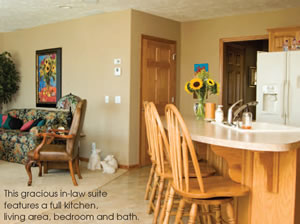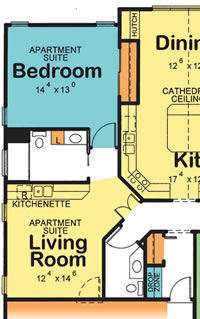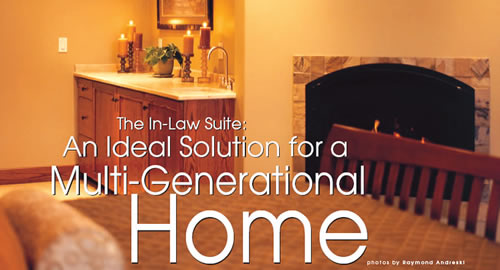In-Law Suites Provide Privacy in the Multigenerational Home
According to the last Census, 3.9 million American homes have three or more generations living together. (Seventy-eight thousand households contain four generations.) “One segment of this growing population is baby boomers caring for aging parents,” notes Janie Murnane, president of Design Basics, LLC.
“Another group consists of younger families who live with able-bodied parents in order to pool finances in expensive housing markets or so they both can afford to live in a nicer home. Having grandparents involved in their grandchildren’s lives and available for babysitting is an added bonus.
“The last group is made up of empty nesters who welcome their grown children back for a period of time to help them get on their feet financially after graduating from college, losing a job or going through a divorce.
“A well-designed in-law suite can make sharing a household much more enjoyable for everyone. But before getting started, it’s important to check local codes to see if there are any restrictions. For example, some municipalities prohibit a single-family home from having two full kitchens or a suite having a separate entrance. Others will allow these options, but will require homeowners to verify a relative is living in the space.”
PRIVACY
 “Privacy is one of the most important features to consider,” comments Design Basics Custom Home Designer Marshall Wallman. “A home that provides private spaces for each generation and comfortable, common gathering areas offers the best of both worlds.
“Privacy is one of the most important features to consider,” comments Design Basics Custom Home Designer Marshall Wallman. “A home that provides private spaces for each generation and comfortable, common gathering areas offers the best of both worlds.
“Location is the obvious starting point. Commonly, the in-law suite is located on the main floor in case there are accessibility issues at some point. In a ranch, it should be separated from the other bedrooms.
“Creating a suite on another level offers extra seclusion. In a 1-story home, it may be the only bedroom suite on the main level– which may later become the master suite.
“ Finished lower level suites work well if the family members don’t have mobility problems or if an elevator can be added. I designed one home for a couple who had two bedrooms in the basement for the wife’s parents; the parents used the rec room’s bar for their kitchen.”
“If the family entertains frequently in the basement, the in-laws may prefer a separate kitchenette so they don’t feel like they’re intruding,” remarks Carl Cuozzo, also a custom home designer with Design Basics.
“I designed an in-law suite on a second level for an active widow who lived with her daughter and son-in-law,” Cuozzo continues. “I stacked two closets on the main floor and upper level so that an elevator could easily be added if it was ever needed.“ Having the suite near an outside entrance to the home or including its own exterior door adds privacy to the suite – so visiting friends don’t have to come through the rest of the home.”
Soundproofing is a final way to maintain privacy. Older people who are hard of hearing may turn their television volume up; young adults also enjoy listening to movies and music louder than other family members prefer. “ Using insulation, sound board (special dry wall), two layers of dry wall or sound channels (corrugated rubber behind the dry wall) in interior walls and solid doors will help quite a bit,” advises Cuozzo.
“Adding an acoustical wall covering will help absorb sound as well,” adds Grant Gribble of Gribble Interior Group in Orlando and a national spokesperson for the American Society of Interior Designers. “So will drapery and other soft surfaces.”
LAYOUTS
 “ It’s so important to make the other generation feel they have their own space that’s not just an offshoot of the main home,” says Gribble. “Even a simple kitchenette – with a small table, microwave, sink and fridge – will allow them to have breakfast by themselves, warm up some leftovers or have a snack on their own schedule.”
“ It’s so important to make the other generation feel they have their own space that’s not just an offshoot of the main home,” says Gribble. “Even a simple kitchenette – with a small table, microwave, sink and fridge – will allow them to have breakfast by themselves, warm up some leftovers or have a snack on their own schedule.”
“In a smaller suite that doesn’t have its own living space, it’s preferable t o a t l e a s t have a bedroom big enough to accommodate a sitting area for a loveseat, a couple of chairs and a television set, so the residents can entertain guests privately,” observes Cuozzo. “ A roomy walk-in closet is also important. It can be difficult for people to part with too many belongings, especially items with sentimental value.”
AMENITIES
If the in-law suite will be used by aging parents, incorporating some universal features in the beginning will be most cost effective. “It may only cost $6 extra to put in a 36-inch door during construction, but it could cost $650 to change it later,” explains Wallman.
“The bath should receive special attention. Extra space around the toilet is another thing that is hard to add later,” notes Gribble. “A no-threshold, trackless shower will be the most accessible. Vinyl or linoleum flooring and rounded corners can reduce the possibility of injuries. Another accessible feature, an elongated toilet, provides a higher end appearance at the same time. An elevated commode may also be desirable – provided residents aren’t small in stature.
“Installing backing materials in the walls for possible grab bars around the toilet is a way to make the bath universal-ready. There’s also a company that makes grab bars that actually enhance a bath’s decor rather than fight against it. Their web site, www.GreatGrabz.com offers grab bars that are almost sexy, with matching towel racks, toilet tissue holders and robe hooks.
“Incorporating lots of natural light (ideally with a view) and plenty of ambient lighting will keep the space cheery and be particularly appreciated by anyone over 50, experiencing changes in vision. If homeowners are concerned about having too much light, they can always install dimmers.
FUTURE USES
While planning an in-law suite, it’s wise to remember it may only be used for a limited time. Make sure it can flex to other purposes when it’s no longer needed; perhaps it may be used as a guest suite, a home office or a master suite. Be careful not to design a space so specialized it would impair the home’s future resale value.
Photos by Ray Andreski.
Originally Printed in the Fall 2006 issue of Design Basics Her Home Magazine.

